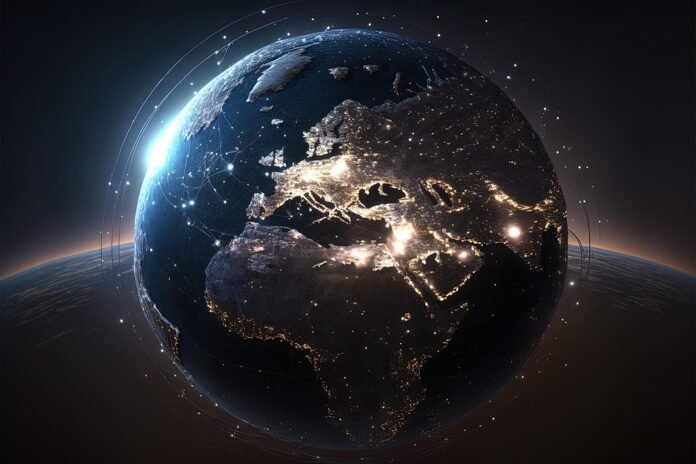Here is an article exploring the complex relationship between AI, art, and the concept of a soul.
Can a Machine Have a Soul? AI’s Foray into Art and Creativity
A swirling, dreamlike cityscape emerges from a nebula of impossible colours. A portrait captures a face that has never existed, yet its eyes hold a universe of unspoken sorrow. A symphony swells with a melody both alien and deeply familiar. These are not the works of a forgotten master or a rising new artist. They are the creations of artificial intelligence.
In the last few years, generative AI has exploded from a niche technological curiosity into a global cultural force. With a few typed words, anyone can conjure breathtaking images, compose music, or write poetry. The results are often so stunning, so emotionally resonant, that they force us to confront a question once relegated to science fiction: Can a machine have a soul?
The question itself is a philosophical minefield. For centuries, we have considered the “soul” to be the seat of consciousness, emotion, and the ineffable spark that makes us human. We see it expressed in art—the messy, beautiful, and deeply personal outpouring of a lived experience. So, when an algorithm produces something that looks and feels like art, what are we actually seeing?
The Ghost in the Machine’s Canvas
To understand AI art, we must first understand how it’s made. AI models like Midjourney, DALL-E, and Stable Diffusion are not “thinking” in a human sense. They are unimaginably complex pattern-recognition systems. Trained on vast datasets containing billions of images and texts from across human history, they learn the statistical relationships between words and pixels.
When you type “a lonely astronaut looking at a shattered Earth,” the AI isn’t feeling loneliness. It is mathematically weaving together concepts it has learned from countless sci-fi illustrations, photographs, and paintings that humans have tagged with words like “lonely,” “astronaut,” and “Earth.” It is a master mimic, a digital collage artist with access to the entirety of our visual culture. The result can be astonishingly coherent and evocative, a kind of echo of the collective human psyche.
The Missing Ingredient: Lived Experience
This is where the argument for a human-exclusive soul finds its strongest footing. A human artist creates from a place of intention and experience. Vincent van Gogh’s “The Starry Night” is not just a collection of pixels representing a night sky; it is a manifestation of his turbulent mind, his yearning, his confinement, and his unique perception of the world. Frida Kahlo’s self-portraits are visceral chronicles of physical pain and emotional resilience. This art is born of scraped knees, first heartbreaks, quiet moments of joy, and the profound ache of loss.
An AI has no such inner life. It has never felt the warmth of the sun, the sting of rejection, or the quiet awe of a sunset. It simulates emotion by referencing data; it does not feel it. The sorrow in the AI-generated portrait is not its own; it’s a reflection of the thousands of sorrowful human faces it studied. The creativity is a brilliant remix, but it lacks the essential ingredient of a personal “why.” The soul, many argue, is forged in the crucible of a life lived, not calculated in a server farm.
A New Partner in Creation
Perhaps the question is framed incorrectly. Instead of asking if a machine can have a soul, maybe we should ask how it can augment our own. Throughout history, technology has always changed art. The invention of the camera did not kill painting; it liberated it from the burden of pure realism, paving the way for Impressionism and abstract art. The synthesizer didn’t replace the orchestra; it created entirely new genres of music.
AI can be seen as the next revolutionary tool—a collaborator, a muse in the circuit board. An artist can use AI to rapidly prototype ideas, break through creative blocks, or generate surreal landscapes that their own mind might never have conceived. In this partnership, the human provides the prompt, the curation, the critical eye, and the overarching intent. The soul of the work, then, lies not in the machine’s output alone, but in the collaborative act of creation. The human guides the soulless tool to express a deeply human vision.
The Soul in the Eye of the Beholder
There is one final, crucial element in this debate: the audience. Art is not complete until it is experienced. Meaning is not just embedded by the creator; it is projected by the viewer. If an AI-generated image makes you feel a profound sense of wonder or nostalgia, is that feeling any less real because of its origin?
The “soul” of an artwork might not reside exclusively in its creation but in the connection it forges. When we look at a piece of art, we bring our own lives, memories, and emotions to the experience. The art acts as a trigger, a mirror reflecting our own humanity back at us. In this sense, an AI-generated piece can absolutely possess soul, because we, the audience, give it one.
A Mirror, Not a Soulmate
For now, a machine does not have a soul in any way we understand it. It lacks consciousness, embodiment, and lived experience. It is a powerful instrument of mimicry and recombination.
Yet, its creations hold up a fascinating mirror to humanity. They reflect our collective dreams, our biases, our visual language, and our deepest archetypes, all learned from the data we fed it. The rise of AI art doesn’t signal the death of human creativity. On the contrary, it forces us to define what truly makes us unique.
The quest is not to find a soul in the machine. It is to use this incredible new technology to better explore, understand, and express our own.

